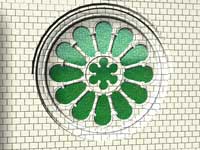 |
 |
 |
 |
 |
 |
 |
|
(2/6) A defining feature of the Cistercian Order was its incorporation of two communities: the monks and the lay-brothers. A large partition, the rood screen, divided the church and separated these two independent groups: the monks occupied the eastern half, the lay-brothers the western half; each had its own choir. Further distinctions according to status and function were marked by sub-divisions that distinguished the sick from the well, participants from servers, members of the community from outsiders. Although the lay-brothers and monks functioned as independent groups and the two choirs were separated, they were linked as part of the wider community and physically connected by a door in the rood screen. On certain occasions, for instance, at the close of a funeral, the lay-brothers might enter the monks’ retrochoir;(2) they may even have entered the presbytery at the Blessing of the Water on Sundays. Divisions were, therefore, not absolute, but in general the two communities remained separate and, at least visually, unaware of the other’s presence. The lay-brothers could hear the monks singing Mass and the Hours, but were not themselves heard, since they were required to celebrate their devotions in silence. The interior of the church was strikingly bare. The walls were plastered white with mock masonry lines drawn in buff or black, and later red. Traces of this have been found at Roche. The Cistercians restricted artificial lighting and regulated against the excessive use of lamps and candles. Natural light was, however, exploited and the windows at Roche, especially those in the transepts, would have provided considerable brightness during the day. Coloured glass was prohibited and at least in the early days clear or grisaille glass was used.(3) However at Roche, as elsewhere, stained glass was later introduced, and pieces of red, blue, green and yellow glass were recovered in the excavations of 1889. They now form a stained-glass window in Lord Scarbrough’s private chapel at Sandbeck. |
|||
|
|

